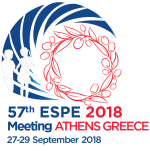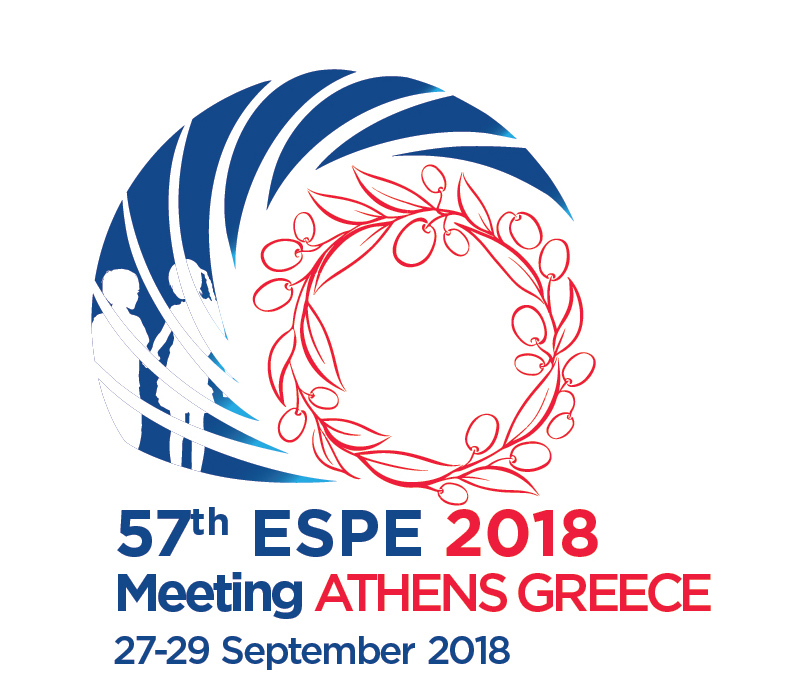
57th Annual ESPE
Athens,
Greece
27 Sep 2018 - 29 Sep 2018

Poster Presentations
Thyroid P1
hrp0089p1-p248 | Thyroid P1 | ESPE2018
Early Determinants of Thyroid Function Outcome in Children with Congenital Hypothyroidism and a Normally Located Thyroid Gland: A Regional Cohort Study
Saba Carole , Guilmin-Crepon Sophie , Zenaty Delphine , Martinerie Laetitia , Paulsen Anne , Simon Dominique , Santos Sophie Dos , Haignere Jeremy , Mohamed Damir , Jean-Claude Carel , Juliane Leger
hrp0089p1-p249 | Thyroid P1 | ESPE2018
Neonatal Screening for Congenital Hypothyroidism: Age-dependent Reference Intervals for Dried Blood Spot TSH in the Neonatal Period
Corbetta Carlo , Angelis Simona De , Rotondi Daniela , Alberti Luisella , Cassini Pamela , Mariani Tiziana , Caiulo Silvana , Vigone Maria Cristina , Weber Giovanna , Olivieri Antonella
hrp0089p1-p250 | Thyroid P1 | ESPE2018
Thyroid Scintigraphy in the Diagnosis of Congenital Hypothyroidism
Woth Chris , Banerjee Indi , Hird Beverley , Patel Leena , Tetlow Lesley
hrp0089p1-p251 | Thyroid P1 | ESPE2018
Congenital Hypothyroidism (CH) with Delayed TSH Elevation: The Importance of The Second-Screening Strategy and the Evolution of CH in Preterm Infants
Caiulo Silvana , Vigone Maria Cristina , Olivieri Antonella , Frenna Marianna di , Vincenzi Gaia , Barera Graziano , Corbetta Carlo , Weber Giovanna
hrp0089p1-p252 | Thyroid P1 | ESPE2018
Morning Versus Bedtime Levothyroxine Administration: What is the Choice of Children?
hrp0089p1-p253 | Thyroid P1 | ESPE2018
Long Term Comparison between Liquid and Tablet Formulations of L-Thyroxine (L-T4) in the Treatment of Congenital Hypothyroidism (CH)
Vigone Maria Cristina , Ortolano Rita , Vincenzi Gaia , Pozzi Clara , Ratti Micol , Assirelli Valentina , Vissani Sofia , Cavarzere Paolo , Mussa Alessandro , Gastaldi Roberto , Mase Raffaella Di , Street Maria Elisabeth , Trombatore Jessica , Weber Giovanna , Cassio Alessandra
hrp0089p1-p254 | Thyroid P1 | ESPE2018
Isolated Congenital Central Hypothyroidism due to a Novel Mutation in TSH Beta Subunit Gene
Kirkgoz Tarik , Ozhan Bayram , Cetin Ozan , Kaygusuz Sare Betul , Turan Serap , Bereket Abdullah , Guran Tulay
hrp0089p1-p255 | Thyroid P1 | ESPE2018
Patterns of Thyroglobulin Levels in Infants Referred With High TSH on Newborn Screening, Compared with Iodine-sufficient Healthy Controls
Kallali Wafa , Neumann David , Krylova Katerina , Jones Jeremy H. , Smith Karen , Shaikh Guftar , Donaldson Malcolm
hrp0089p1-p256 | Thyroid P1 | ESPE2018
Mutation Screening in 60 Chinese Patients with Congenital Hypothyroidism
Zheng Zhangqian , Lu Wei , Wu Jing , Luo Feihong
hrp0089p1-p257 | Thyroid P1 | ESPE2018
Results of the hTPO Mutational Screening in Bulgarian Patients with Congenital Hypothyroidism (CH)
Stoeva Iva , Mihova Kalina , Stoilov Boris , Koleva Reni , Mladenov Wilhelm , Iotova Violeta , Kaneva Radka
hrp0089p1-p258 | Thyroid P1 | ESPE2018
Thyroid Hormone Resistance Beta: Eighteen Pediatric Patient Experience
Siraz Ulku Gul , Direk Gul , Akin Leyla , Bircan Rıfat , Tatli Zeynep Uzan , Hatipoglu Nihal , Kendirci Mustafa , Kurtoglu Selim
hrp0089p1-p259 | Thyroid P1 | ESPE2018
A Novel Mutation of IGSF1 Gene
Sotiridou Ellada , Schoenmakers Nadia , Datta Vipan
hrp0089p1-p260 | Thyroid P1 | ESPE2018
Multinodular Goiter in Childhood: A Diagnostic Gateway for Screening DICER1 Syndrome
Petit Isabelle Oliver , Grunenwald Solange , Golmard Lisa , Savagner Frederique
hrp0089p1-p261 | Thyroid P1 | ESPE2018
A Novel DICER1 Mutation Identified in a Family with the Multinodular Goiter of Children
Nagasaki Keisuke , Shibata Nao , Nyuzuki Hiromi , Sasaki Sunao , Ogawa Yohei , Kogai Takahiko , Hishinuma Akira
hrp0089p1-p262 | Thyroid P1 | ESPE2018
Subclinical Hypothyroidism, Thyroid Nodule or Cyst in Prepubertal Children: How Many Children were Diagnosed at Age 6?
Lee Young Ah , Cho Sun Wook , Lim Youn-Hee , Kim Johanna Inhyang , Kim Bung-Nyun , Hong Yun-Chul , Park Young Joo , Shin Choong Ho , Yang Sei Won
hrp0089p1-p263 | Thyroid P1 | ESPE2018
Expression of ZnT8 Transporter in Thyroid Tissues from Patients with Immune and Non-Immune Thyroid Diseases
Bossowski Artur , Reszec Joanna , Polnik Dariusz , Gasowska Marta , Niklinska Wieslawa
hrp0089p1-p264 | Thyroid P1 | ESPE2018
Thyroid Nodules in a Childhood Cancers Survivors Population: A Monocentric Experience
Peschiaroli Emanuela , Ubertini Graziamaria , Grossi Armando , Ferro Giusy , Martini Ludovica , Paone Laura , De Pasquale Maria Debora , Ferroli Barbara Baldini , Cappa Marco
hrp0089p1-p265 | Thyroid P1 | ESPE2018
HLA Alleles and Amino Acid Variants of HLA-A, -B, -C, -DRB1, -DQB1, -DPB1 Molecules in Early-Onset Autoimmune Thyroid Disease
Cho Won Kyoung , Shin Dong Hwan , Kim Seul Ki , Lee Seonhwa , Choi Yujung , Ahn Moonbae , Baek In Cheol , Jung Min Ho , Kim Tai-Gyu , Suh Byung-Kyu
hrp0089p1-p266 | Thyroid P1 | ESPE2018
Childhood Thyroid Autoimmunity and Relation to Islet Autoantibodies in Children at Risk for Type 1 Diabetes
Jonsdottir Berglind , Larsson Christer , Jonsson Ida , Lundgren Markus , Larsson Helena
hrp0089p1-p267 | Thyroid P1 | ESPE2018
Evaluation of Serum Concentrations of Selected Cytokines OPG and sRANKL in the Diagnosis of Autoimmune Thyroid Disease in Children
Mikos Hanna , Mikos Marcin , Niedziela Marek
hrp0089p1-p268 | Thyroid P1 | ESPE2018
Analysis of Zinc-Transporter ZnT8 Autoantibodies in Children and Adolescents with Autoimmune Thyroid Diseases
Michalak Justyna , Rydzewska Marta , Bossowski Artur
hrp0089p1-p269 | Thyroid P1 | ESPE2018
The Association between TSHR, IFIH1 and ETV5 Polymorphisms with Graves’ Disease and Diabetes Mellitus Type 1 in Children
Stozek Karolina , Wawrusiewicz-Kurylonek Natalia , Goscik Joanna , Wasniewska Malgorzata , Aversa Tommaso , Corica Domenico , Kretowski Adam , Bossowski Artur



